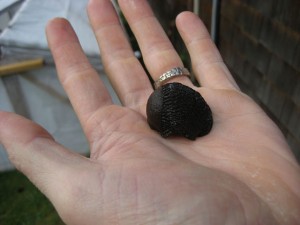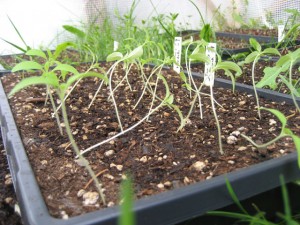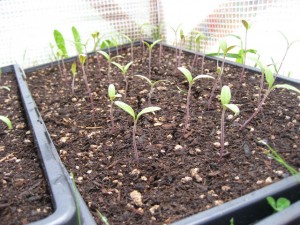We’re slowly easing into full-on work here. As I mentioned a few weeks back, we began seeding the long lead time items first: about 25 flats of peppers, tomatoes, beets, and onions. This presented a bit of a quandary, though, since the greenhouse only holds 25 flats, and it’s already time to get the corn, cucumbers, broccoli, and squash started. After some humming and hawing, I finally decided we can’t afford to build another greenhouse this season. But it’s still not warm enough to leave new seedlings outdoors, so I want to the co-op and bought some wire hoops and sheet plastic to make a VERY temporary tunnel-type greenhouse, just to get this new batch of seedlings through the first two weeks or so.
Of course, that isn’t a problem until they germinate. Right now, I have all the second batch of flats sitting on the side table in my office, where it’s nice and toasty. You see, most of these seeds need 70+ degree soil temperature to germinate, but once they’re started, you can move them somewhere cooler. That’s good; I want my office back. But we also discovered that the move outdoors not only helps our space issues, but also makes the plants stronger. Here we have pictures of two different flats of Chadwick Cherry Tomatoes. They were planted at the same time, in the same soil, with seeds from the same supplier. The difference? The ones on the left are “leggy,” weak-stemmed from spending too many days indoors by a window before being moved outside. They stretched to their limit to get to the sunlight, and didn’t build up any strength against wind because there isn’t any in our house (thankfully). The ones on the right a a little shorter, but much stronger and healthier. We’d read about this phenomenon before, but nothing really drives home the lesson like seeing it happen firsthand.
So, we kept most of the first round of flats in the house until they germinated, then moved them out to the greenhouse. In the case of the peppers, that was a lot of waiting. They are so slow to start, and the anticipation is made worse by how much I want to have jalapeños and cayennes and sweet bells this sumer.
 Imagine my dismay this evening when I went to check the greenhouse, and saw that ALL OF MY PEPPERS EXCEPT FOR A DOZEN WERE GONE. Close inspection revealed that there were a scant few leafless stems left, but most had been eaten right down to the ground. The culprit? This guy, and his relatives.
Imagine my dismay this evening when I went to check the greenhouse, and saw that ALL OF MY PEPPERS EXCEPT FOR A DOZEN WERE GONE. Close inspection revealed that there were a scant few leafless stems left, but most had been eaten right down to the ground. The culprit? This guy, and his relatives.
Things have been hard around here lately, and this was one of those “straws that broke the camel’s back.” I just shrugged and went inside. Weeks of work, down the drain. Luckily, Emily took over and came to the rescue. She’s placed beer traps in the greenhouse to catch the slugs before they cause more mischief, and is talking about getting some “sluggo” next week as a backup.
But questions remain. Will the beer traps be effective? Can we get more peppers replanted and germinated in time to still have a harvest this season? Ugh. I guess we’ll find out.
In other news, I pruned the second half of the orchard today. Pomme fruit (apples, pears, and things with multiple seeds) are pruned in late winter, so the tree doesn’t waste any sap on branches that will be removed in the pruning process. But for stone fruit (peaches, plums, apricots, etc) they are not pruned until the spring is under way. There are a few diseases that can get into the pruning wounds if they are left open during the cold, wet winter, and if the sap is running, it helps to better protect them.



